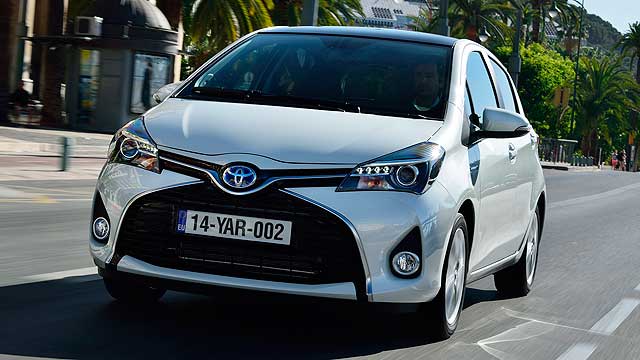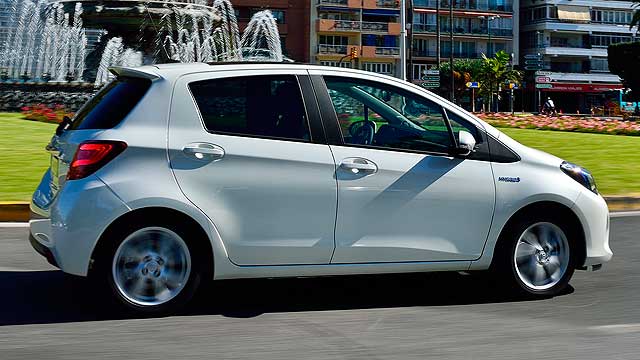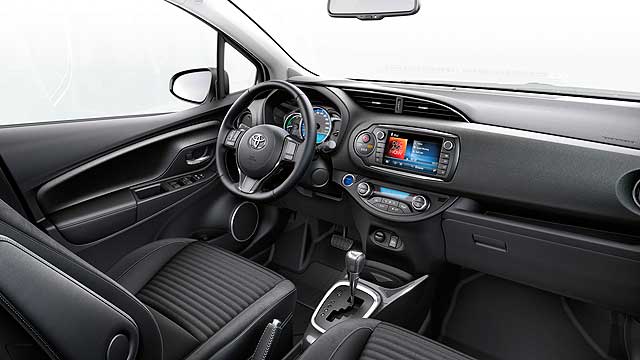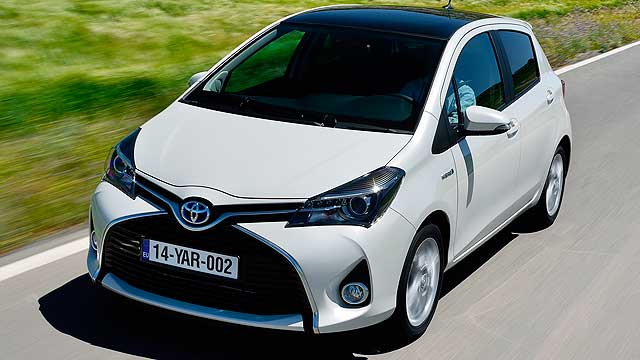
- £70 million mid-life facelift for Toyota Yaris
- 1000 new parts and three years’ development for firm’s best-selling European car
- Priced from £9995 | On sale now, deliveries August 2014
RICHARD AUCOCK | JULY 2014
If there’s one thing a Toyota is not, it’s poor quality. The Toyota Production System ensures everything it does is near-flawlessly engineered and meticulously built. So imagine the horror in Japan when first reports of the third generation Yaris were dominated by talk of its cheap, plasticky and, shock, poor-quality interior. Career pride destroyed, possibly.
Add in grumbles about the poor ride, plain design and general lack of appeal, and it was straight back to the drawing board for the brand. Literally. And immediately. But this time, for the first time, it was Europe leading the team, not Japan. Swords, fallen, etc.
Somehow, Toyota Europe convinced Toyota HQ to spend big on this facelift. Almost £70 million, in fact, for changes way beyond a normal mid-model update. Japan even tacitly agreed it needed to, that the original car was deficient, that there was plenty to do; we’ve detailed the changes elsewhere. Safe to say this is far more than just a new set of lights.
Toyota’s also brought the Hybrid design in line with the regular 1.0-litre and 1.33-litre petrols and (now nearly pointless) 1.4-litre D-4D. Because Hybrid IS now a volume model, taking 25% of sales this year and set to hit a 40% model mix by 2016. It’s still unique in the sector (c’mon, supermini rivals!) and, now it’s hit the 75g/km CO2 mark, is set to become the core of the model range.
The Yaris is already a strong seller (perhaps surprisingly so), ranking 6th in full year 2013 UK supermini sales and, year to date, sitting fourth in the supermini sales chats. But those sales have been worthy but dull ones, hardly the stuff that makes sector stardom. Enough, says Toyota: the Yaris has now got serious. So has the spend been worth it?
What’s the 2014 Toyota Yaris like to drive?

The base driving level of the Yaris has been transformed. Previously, it was a rather lumpy thing, with a nervous feel but no real engagement to show for it. By softening the springs but fitting an all-new rear torsion beam and expensive new dampers, plus extensive changes to the body structure that make it 20% stiffer, it’s now much more pliant and easygoing.
The harshness in town is much-reduced, it’s quieter over bumps and more settled at speed, both on straights and over undulations. It feels more grown up, like a more expensive car, and reprogrammed EPAS gives firmer, more confident steering without making it stiff or over-heavy.
The pay-off is pronounced body roll if you chuck it about but there’s enough accuracy for you to go quickly without doing this. Besides, it doesn’t fall apart if you do fling it into bends; body lean is no indication of lacking suspension integrity. What it isn’t is fun, though. Sophisticated and sensible, yes, but very much steering towards the Polo rather than the Fiesta.
As before, the 1.33-litre engine really needs stocking as it’s very torque-deficient at low revs. It’s a bit boomy near the redline but the mechanical sound is also quite enthusiastic. Much better, though, is the cheaper 1.0-litre three-pot. A bit of tickover shimmer apart, it’s generally smoother, quieter and more refined, while its more wakeful response to the throttle makes it feel gruntier even if, when revved, you discover it isn’t. Taken from the new Aygo, it feels like a true ‘Yaris’ engine.
The Hybrid is clever in how it so seamlessly blends electric and petrol motion in town, with the hybrid operation being broadened for 2014 thanks to changes in the system’s logic. It feels expensive in town, because of the quietness, and you get used to the CVT-petrol’s slippy-clutch drone when pressing on, although it will get on your nerves if you often drive like that. For most, much of the time it’ll be quieter and more pleasant than a diesel.
We didn’t get to drive the diesel. Not many customers will either; Toyota dealers will (rightly) advise they spend £600 more on the Hybrid instead.
Has Toyota pulled off a great automotive turnaround?

The Yaris looks a lot better than before. The big, shouty ‘X’ front end design helps – quieten it down with some MOR metallic, spice it up with a sport pack that includes black alloys – but detail tweaks throughout, such as a smoothed-out rear end and cool LED lights, help make it look classier.
The interior is leagues apart too. The old one took your breath with how craggy it all was; it was hard to believe it passed into production, so rough, cheap and shiny was it all (no wonder Toyota HQ took the project away from Japan and gave it to Europe). Now, it’s awash with soft-touch plastics, classy finishes and, if simplicity and ergonomic clarity’s your thing, real rational appeal.
Visibility remains excellent, there’s lots of space (the rear’s a bit Tardis-like: space looks so-so but a high seat bench and plenty of space for feet under the front seats means it’s surprisingly comfortable) and the Toyota Touch 2 infotainment system is superb. Big, responsive and four times the resolution of before, choosing the £650 Go nav upgrade genuinely brings the online, app-laden functionality of a premium car.
But a car transformed? Well, it’s good, but it’s still not a class-leader. The Polo has that extra layer of quality and the Fiesta, well, you know how highly we regard that. What the Yaris now does is compete very ably with cars such as the Clio and 208, and provides endless level-headed relevance to those who may be thinking about the aged Corsa.
It is an able, well-judged supermini that does ‘being a Toyota’ extremely well; a genuine level 2 alternative in a way the old one simply was not. And if transformation from an also-ran into a contender is a measure of automotive turnarounds, then Toyota is right up there.
MR VERDICT: 2014 Toyota Yaris

If we were buying a supermini, we’d still hanker after a Fiesta and try to find the extra pennies for a Polo. But we can see the merit in the Yaris now, thanks to its refreshed styling, overhauled interior and far-reaching dynamic changes. It’s a very easy car to live with, just like a Toyota should be; the old one was not.
The USP of an affordable hybrid remains too, and it’s this that lifts the Yaris into four-star ranking territory. To get decent supermini with a high-tech hybrid engine 90+ official mpg, 75g/km AND decent tax-breaks, for just over £16k, is standout stuff. No wonder Toyota’s banking on selling so many. Now, at last, we can justify the decision.
Rivals
- Ford Fiesta
- Volkswagen Polo
- Renault Clio
- Peugeot 208
- Vauxhall Corsa
The Ford Fiesta is a class act to drive; the supercar of the supermini sector. It’s not the cheapest or most practical, but it doesn’t matter. The Polo is the classiest, the Clio combines Fiesta and Polo talents surprisingly well and the 208 looks cure and is interesting inside. Lots of people drive Corsas, but with the current car, it’s a white goods decision. The firm’s crossing fingers things are different for the imminent new one.
Specification: 2014 Toyota Yaris
Engine 1.0-litre petrol, 1.33-litre petrol, 1.5-litre petrol-electric hybrid, 1.4-litre diesel
Gearbox Five/six-speed manual, CVT, AMT
Price from £9,995 (including £1000 discount)
Power 68-98hp
Torque 70-92lb ft
0-62mph 10.8-15.3 seconds
Top speed 96-109mph
MPG 67.3-85.6
CO2 75-114g/km